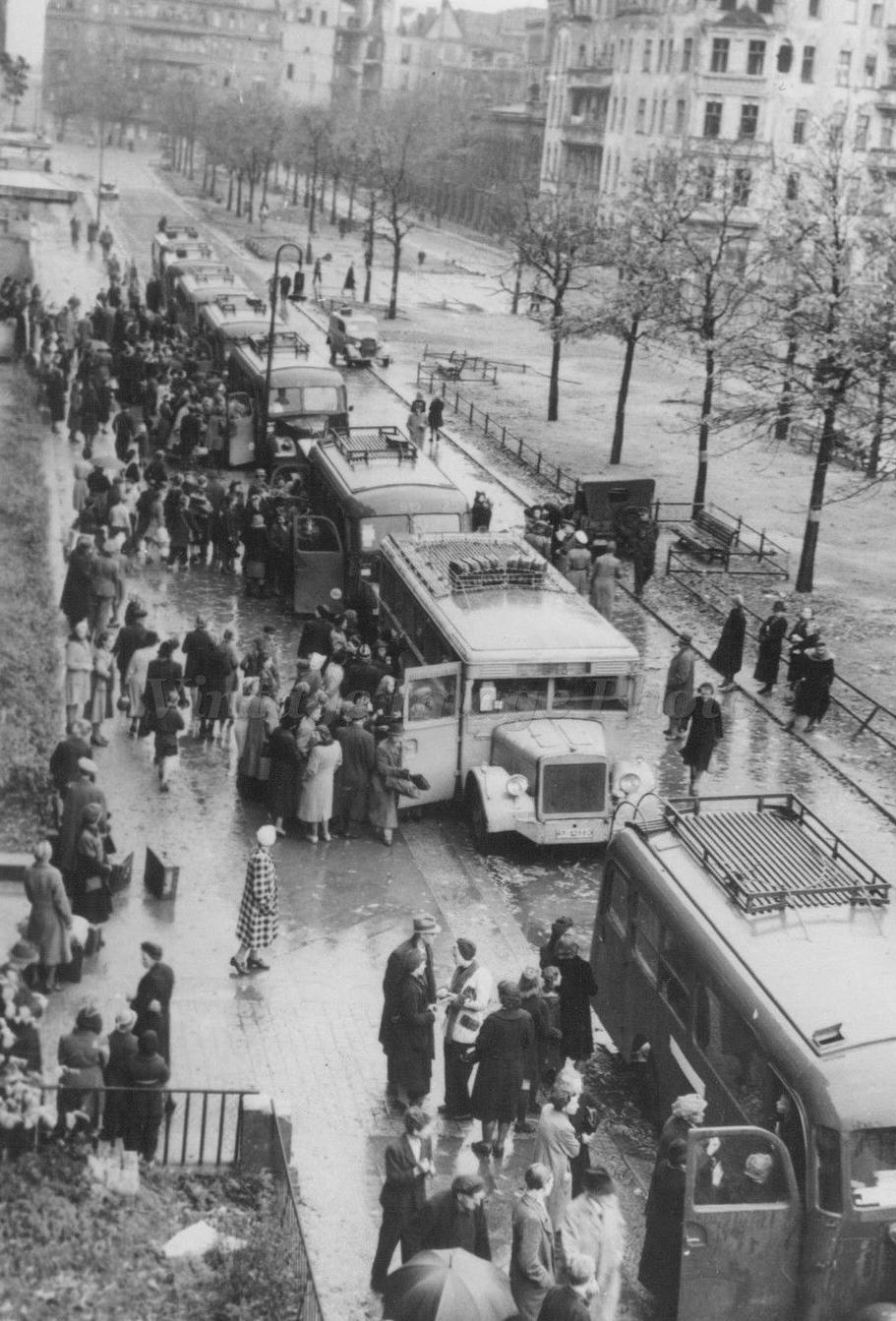
World War II Aftermath in Berlin: Living Conditions

Figure 1.-- The situation in Berlin became even worse as the first post-War winter approched. Families could live in damaged homes during the summer. Living in homes with holes in the wall and without coal was a different matter. The British descided to find temprarch homes for some of the children in their occupation zone of Germany. Here re the children loading on to busses. The caption of this press photo read, "Transportation for German Children: Grman school children are boarding some of the 50 busses used to carry 1,600 childrenfrom Berlin to Westphalia as a precaution against the outbreaks of epidemics in the capital. Relatives and friends are bidding th youngsters goodbye before theirdeprture from the Hansa School in the Tiergarten district on October 26 [1945]. British authorities are evacuating some 50,000 because of the food, fuel, and housing shortages."
|
|
Conditions in the Berlin at the end of the War were terrible. Much of the city was vast piles of rubble. Much of the population had lived in large, multi-story apartment blocks. Some 0.6 millio apartments have been destroyed. Only 2.8 million of the city’s original population of 4.3 million still lived in the city. Some had been killed in the Allied bombing, but because od an efficent CD progrm, less than might be expected. Most of missing people had fled the city. This was largely done on their owm. Except for the KLV child evacuation program, the NAZIs never organized an evacution of the city. Most of the population left in the city was women, children, and old men. Photographs show the devastation of the German capital and capture the desperation of Berliners after the War. An American reporter describes what he saw in July 1945. "With some friends, I walked one day down the short, narrow Oberwallstrasse, which runs off Unter den Linden. What we saw there can, with a few variations, can be seen today in hundreds of Berlin side streets. A wrecked American half-track with S.S. license plates lay keeled over to starboard, and other military vehicles were strewn along behind it. Half of one large dwelling house had been sheared off, leaving four stories of rooms exposed to view. In one ground-floor room stood a small lathe which had doubtless been used to make parts of military instruments; during the war there was a great deal of parlor manufacture, in Berlin. Halfway up the street, an elderly woman and a little girl were foraging for fuel in another wrecked house. A sign on one wall of it said, in German, 'Warning! As per order of the Herr Police President of Berlin, this property has been strewn with a highly poisonous rat exterminator. Children and domestic animals are to be kept at a distance.' The old woman and the little girl hadn't read the sign or, more likely, didn't care. Under a fallen joist the child found a man's left shoe, in fairly good condition, and this she put into her rucksack. Single shoes are a commodity on Germany's black market." [Sayre] Berliners experienced the destruction and despertion they had inflicted on a whole continent. There were severe food shortages. Water mains and sewage systemns were destroyed. Disease was rampant and sewage everywhere. The stench was terrible. Luckily the weather had begun to warm up as coal was unobtainable. Rail links with the coutryside and rest of Germany were destroyed. The Soviets as agreed in the London Protocol (September 1944) and Yalta (February 1945) allowed the Western Allies in to set up a four-power occupation. Those who survived had no way of making a living. Factories were destroyed. Shops were closed because goods were unavailable. Food was the most immediate problem, but housing because of all the destruction was also huge problem. Life in the city became never ending hunger, disease, housing shortages, unemployment, and abject poverty. The Allies hired mostly women to begin the clear away the rubble. But even mong the rubble we see playing among the ruins. The situation became even worse as the first post-War winter approchd. Families could live in damaged homes during the summer. Living in homes with holes in the wall and without coal was a different matter.
CIH -- WW II

Navigate the CIH World War II Pages:
[Return to Main conditions in Berlin after the War]
[Return to Main Berlin after the War page]
[Return to Main Cold War Berlin page]
[Return to Main World War II German aftermath page]
[Return to Main World War II German page]
[Return to Main World War II page]
[Biographies]
[Campaigns]
[Children]
[Countries]
[Deciding factors]
[Diplomacy]
[Geo-political crisis]
[Economics]
[Home front]
[Intelligence]
[POWs]
[Resistance]
[Race]
[Refugees]
[Technology]
[Bibliographies]
[Contributions]
[FAQs]
[Images]
[Links]
[Registration]
[Tools]
[Return to Main World War II page]
[Return to Main war essay page]
Created: 12:25 PM 12/5/2016
Last updated: 12:25 PM 12/5/2016



